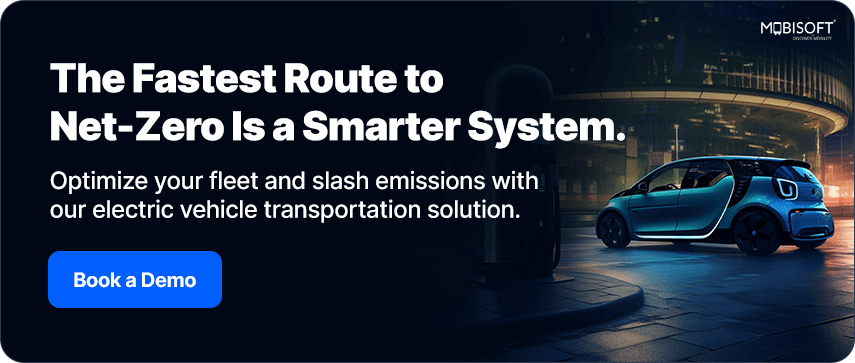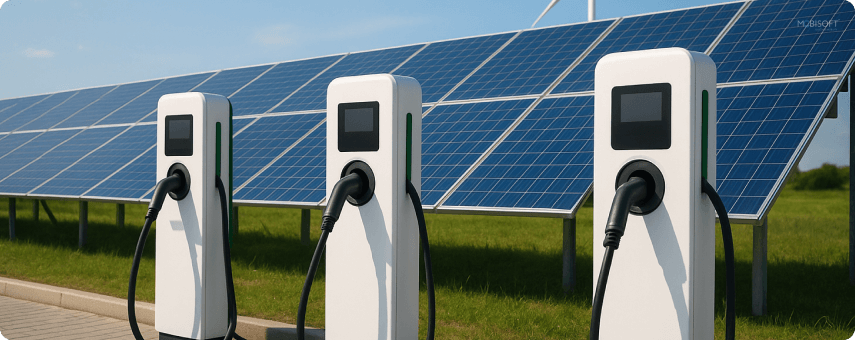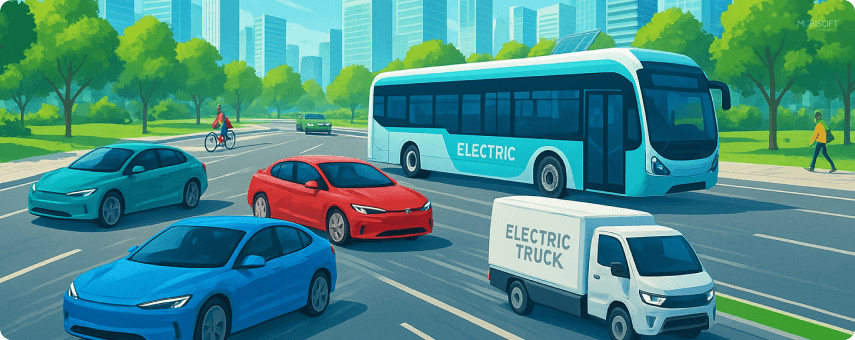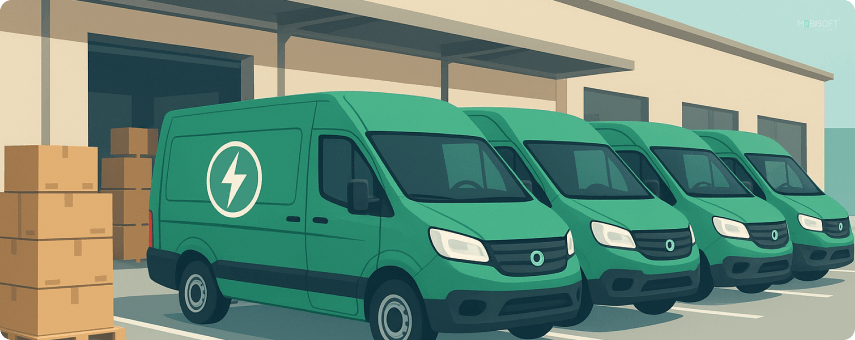Every minute, planes take off, trucks move on highways, buses carry employees, and cars transport commuters. These trips drive the economy but also create one-quarter of global CO₂ emissions.
Transport is both the engine of growth and the bottleneck to net zero mobility. Road vehicles account for about three-quarters of transportation emissions. Then there’s aviation and shipping, which add their own layers of complexity. More than 140 countries have pledged to hit net zero transportation by 2050. The race is definitely on. But here’s the real question: are we making progress fast enough, or are we simply stuck in the traffic jam on the path to sustainable mobility solutions?
As part of this shift, organizations are increasingly exploring electric vehicle transportation solutions to accelerate their journey toward sustainable mobility.
For logistics leaders, airline managers, corporates, and event organizers, the question goes beyond climate talk. This is about making operations resilient for the future. It means looking for ways to trim costs wherever you can. At the same time, there’s pressure to build trust with stakeholders. It matters more as sustainable transportation gives you an edge in the field.
What Transportation Leaders Think: Balancing Carbon, Costs, and Credibility
For transportation and logistics leaders, the debate over mobility decarbonization is no longer abstract. It shows up in three pressing conversations inside boardrooms and operations centers:
How do we actually cut carbon without disrupting service?
Leaders recognize that the simplest efficiency gains are usually the first to cut down empty miles, combining trips and shifting toward shared models like carpooling or shuttle pooling. The tougher work comes later. Moving beyond pilot programs needs a real strategy if you want measurable, scalable impact across fleets and networks. This is where net zero transportation strategies 2025 are starting to take shape.
How will this shape the image of our brand?
Sustainability is now a reputational marker. Airlines that digitize crew transport, corporates that reduce Scope 3 emissions, or event organizers who showcase eco-fleets all strengthen their brand value. For leaders, the risk is being perceived as lagging when peers and competitors step forward with zero emission transportation or green transport technologies.
How do we future-proof operations while staying cost-efficient?
Decarbonization goes beyond the compliance box. It’s about keeping operations strong. Using smart mobility solutions, predictive maintenance, and platforms that connect the whole system helps lower costs right now. The tools set businesses up for a future shaped by carbon pricing, green procurement policies, and scrutiny from investors. For many leaders, this dual focus with sustainability and OPEX optimization is the real decision driver.
To sum up, leaders view transport decarbonization as a strategic chance to cut emissions, enhance brand credibility, and further build operations that are ready for what comes next.

Current Obstacles on the Road to Net Zero Mobility
Despite bold pledges and rising awareness, most transport and logistics teams hit real roadblocks in net zero logistics and mobility decarbonization.
Lack of Reliable Data and Reporting
Many organizations struggle to see their true emissions. Without fleet-level visibility, leaders cannot set baselines, measure progress, or back up their sustainability claims. This is one of the key challenges to net zero mobility.
Fragmented and Manual Processes
Operations are often managed through spreadsheets, calls, and disconnected systems. This leads to inefficiencies like empty miles, idle vehicles, and delayed schedules, directly inflating carbon output.
Limited Integration Across Functions
Transport operations rarely sync with HR, ERP, flight schedules, or event accreditation systems. The result? Overlaps, unnecessary trips, and wasted resources that could otherwise be avoided.
Infrastructure Gaps for Electrification

Even when companies want to adopt electric vehicles for net zero, the lack of EV charging infrastructure, unclear route planning, and downtime risks make a large-scale transition difficult. Similar hurdles apply to scaling hydrogen vehicles in transport or electric buses for net zero mobility.
Cost Pressures and Short-Term Trade-offs
Leaders understand that greener practices save money over time. The challenge comes with the high upfront costs and the pressure of tight budget cycles. In reality, organizations put their energy into meeting today’s service demands. Long-term sustainability planning gets pushed aside, slowing progress on how transportation can achieve net zero.
Discover how smart transportation and logistics solutions can help overcome these challenges while reducing emissions.
Technology as an Enabler: Turning Ambition into Action
Leaders know where they want to go: lower emissions, stronger brand image, future-ready operations. But as we’ve seen, the real barrier to its execution: lack of data, fragmented systems, and infrastructure gaps. This is where technology becomes the bridge from ambition to action in sustainable transportation.
End-to-End Visibility with Real-Time Analytics
You improve what you measure. Advanced dashboards give leaders a clear, data-driven picture of emissions. If it’s per route, per passenger, or per ton-mile. Managing corporate commutes, crew shuttles, or logistics fleets, real-time reports help set baselines, track progress, and tell a solid sustainability story.
Streamlined Operations Through Fleet Optimization
Manual planning falls short, so AI-powered dispatch and routing step in. Matching demand with the right-sized vehicle and cutting empty miles helps organizations reduce fuel costs and emissions. For corporates and events, this means fuller shuttles instead of half-empty ones. For logistics, it enhances asset use and lowers ton-mile costs key to transportation emissions reduction.
Predictive Maintenance for Reliability and Efficiency
When vehicles run below peak levels, they quietly waste fuel and drive up carbon emissions. IoT-based predictive maintenance catches issues before they turn into repairs. This keeps employee shuttles on time, crew vans running smoothly, and logistics trucks working longer with less environmental impact.
Digital Integration Across Systems
Disconnected tools lead to wasted trips and idle vehicles. Integrated platforms sync transport with HR, ERP, warehouse, and accreditation systems. That means:
- Airline schedules automatically trigger crew shuttles.
- Employee rosters feed into transport allocation.
- Event accreditation scans double as vehicle boarding passes.
- Logistics loads are dispatched only when the cargo is ready.
Intelligent EV Transition Support

The path to electrification is risky without planning. Smart route and charging algorithms factor in range, downtime, and charging station availability, ensuring EV fleets are reliable. For corporates and events, this makes deploying eco-fleets practical. For freight operators, it reduces range anxiety in early adoption of electric vehicles and net zero models.
For enterprises, integrating real-time vehicle tracking in transportation ensures greater visibility, fewer delays, and measurable emission reductions.
Sector-Specific Challenges and Solutions: Where Change Becomes Real
Every sector faces its own version of the decarbonization challenge. Here’s how technology-driven solutions can turn roadblocks into opportunities:
Logistics Fleets: Efficiency Before Electrification

Heavy vehicles will take longer to transition fully to electric trucks and hydrogen vehicles in transport. Until then, the biggest lever is efficiency. AI-based dispatching, load consolidation, and predictive maintenance cut fuel use and reduce empty miles. For SMEs, this means measurable carbon savings without heavy upfront investment, making fleets greener and more cost-efficient today while preparing for electrification tomorrow.
Aviation: Rethinking Crew Transportation
Aircraft emissions dominate headlines, but ground-side operations like crew transport are often overlooked. Legacy taxi models and idle shuttle rides waste time, fuel, and carbon. A crew transportation solution that syncs with flight schedules, automates routes, and tracks emissions ensures punctuality while cutting waste. For airlines, this is a tangible, near-term step to reduce their overall footprint and showcase zero emission transportation in a sector under intense scrutiny.
Shipping: Cutting Idle Time at the Margins
Maritime transport accounts for nearly 3% of global CO₂ emissions and faces one of the hardest roads to net zero mobility. Green fuels are years from commercial scale. In the meantime, digital port logistics and intermodal optimization can prevent idle vessel time, optimize crew transfers, and streamline ground cargo handovers, delivering smaller but meaningful gains in sustainable shipping practices.
Corporations: Tackling the Commute Challenge
Employee transport is a major contributor to Scope 3 emissions, yet managed with spreadsheets and guesswork. Empty or half-full shuttles and solo cabs are common.
- Employee transport platforms optimize routes, assign the right-sized vehicles, and provide real-time emission tracking.
- Corporate carpool solutions encourage shared rides, cutting single-occupancy trips and parking demand.
Together, these solutions reduce costs, improve employee experience, and make corporate mobility decarbonization visible and measurable.
To explore this further, check out how corporate carpooling can reduce carbon footprint and foster sustainability, offering organizations a scalable way to cut Scope 3 emissions.
Events: Turning Transport into a Sustainability Showcase

At large sporting events, conferences, and festivals, transport can account for up to 70% of total emissions. The spotlight is on optics organizers who demonstrate sustainable practices to sponsors, audiences, and regulators. Digital event transportation solutions with real-time dashboards, accreditation-linked boarding, and eco-fleet planning transform transport from a logistical headache into a sustainability showcase that strengthens brand reputation.
Learn how enterprise mobility solutions can transform employee commutes into cost-efficient and sustainable operations.
Are Industries Really on Track? A Reality Check
From my vantage point of working closely with logistics providers, airlines, corporates, and event organizers, the picture is mixed. The intent to decarbonize is strong, but execution often falls short.
Logistics fleets
They still depend heavily on diesel. While many talk about electrification, day-to-day operations are often run through manual dispatching and disconnected systems, leading to empty miles and fuel waste. For example, I’ve seen mid-sized fleets send multiple half-loaded trucks on similar routes simply because demand wasn’t consolidated. Without digital fleet optimization, efficiency gains remain limited.
Airlines
They focus their sustainability stories on SAF and aircraft efficiency. Yet, crew transportation, one of the most solvable ground-side emission sources, remains under-optimized. I’ve seen cases where airlines run 40-seater buses carrying fewer than 10 crew members because they lack automated scheduling linked to flight timings. A crew transport platform could have matched demand in real-time and cut both costs and emissions.
Shipping operators
They experiment with green fuels, but port operations and intermodal transfers are still fragmented. For example, trucks often queue for hours at terminals due to poor synchronization, burning fuel while waiting. Digital coordination could cut idle time and emissions immediately, but adoption is inconsistent across ports.
Corporations
They often highlight bold net-zero commitments. However, employee transportation and commuting, one of the largest Scope 3 emission contributors, rarely gets serious attention. I’ve seen organizations run dozens of shuttles daily, many operating at 30 - 40% occupancy. A combination of employee transport platforms and carpool programs could make the same network far leaner.
Event organizers
They face the sharpest spotlight. Transport accounts for up to 70% of event emissions, but in most cases, it’s still treated as a line item cost rather than a sustainability lever. Only a handful of global events, like the Olympics, have begun using real-time dashboards and accreditation-linked transport. Many smaller organizers still rely on paper-based coordination and ad-hoc vendor contracts.
The gap is clear: industries are aware of the problem and have pilot projects underway, but scaling solutions remains the missing link. Too often, leaders know what needs to be done but lack the systems, data, and integration to execute consistently.
See what’s next in logistics by exploring the future of logistics technology.
The Way Forward: Paving the Road to Net Zero Mobility
Net-zero mobility will not be achieved by policy promises alone; it demands industry action powered by technology, data, and smart mobility solutions. The pathway is a series of scalable steps that industries can take today.
Make Data the Starting Point
Without accurate emissions data, transport decarbonization is guesswork. Logistics fleets, crew shuttles, or corporate commutes all need real-time reporting dashboards to baseline and track. Transparent data also builds credibility with regulators, investors, and customers.
Prioritize Efficiency Before Electrification
EV adoption is critical, but waiting for infrastructure maturity is risky. Leaders must start by optimizing existing fleets, cutting empty miles, right-sizing vehicles, and reducing idle time. These are carbon and cost savings available now.
Integrate Transport Into Core Systems
Disjointed planning leads to waste. The future lies in integrated mobility platforms where transport syncs with HR, ERP, flight scheduling, or event accreditation. This avoids duplication, cuts empty runs, and ensures resources are deployed efficiently.
Scale Shared and Sustainable Models
Carpooling for corporates, pooled shuttles for events, and shared crew rides in aviation all deliver immediate reductions in transportation emissions. These models also improve user experience and lower costs.
Build EV-Ready Ecosystems
This makes sure electrification supports reliability, rather than getting in the way of day-to-day operations. Early movers in corporate and event fleets are demonstrating that electric vehicles scale well when planning is solid. The message is straightforward.
The journey to net-zero mobility depends on smart digital tools, tight operational efficiency, strong integration, shared models, and solid readiness for EVs. Taking these steps does more than further sustainability. You also strengthen your brand, control costs, and build long-term resilience for the organization.
Get deeper insights into optimizing fleets with modern fleet management and transportation technology.
Conclusion: From Vision to Action
Net zero mobility has become a business, brand, and operational imperative. Leaders across logistics, aviation, corporates, and events already understand what is at stake. The real challenge is execution at scale.
The way forward starts with measurement. Organizations need credible data baselines to avoid greenwashing. Once numbers are in place, the next step is cutting inefficiencies before chasing large-scale electrification.
Another key step is integration. Transport must not run in silos, be it across departments, locations, or service providers. A unified system creates visibility and coordination. Shared models then add further value.
Organizations take steps to future-proof their operations, enhance brand reputation, and build stakeholder trust.
Here are a few examples:
- Airlines with digitalised crew transportation show reliability and sustainability both in practice.
- Corporations that optimize commutes and encourage carpooling cut Scope 3 emissions while improving employee experience.
- Logistics providers that digitize dispatch and maintenance bring down ton-mile costs and secure a competitive advantage.
- Event organizers who adopt eco-fleets and real-time dashboards turn transport into a showcase of sustainability rather than a cost center.
Net-zero mobility is now practical. The tools exist, the solutions are proven, and the benefits extend beyond compliance. The real question is simple: how fast will leaders act to make sustainable mobility a reality?





 July 4, 2025
July 4, 2025


